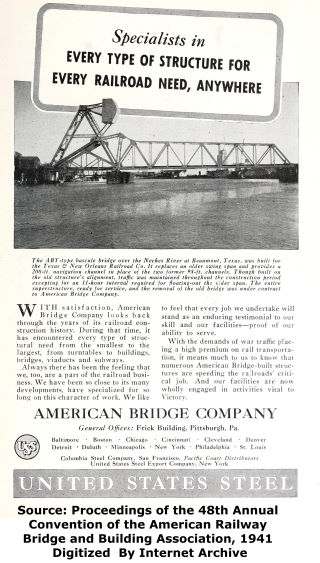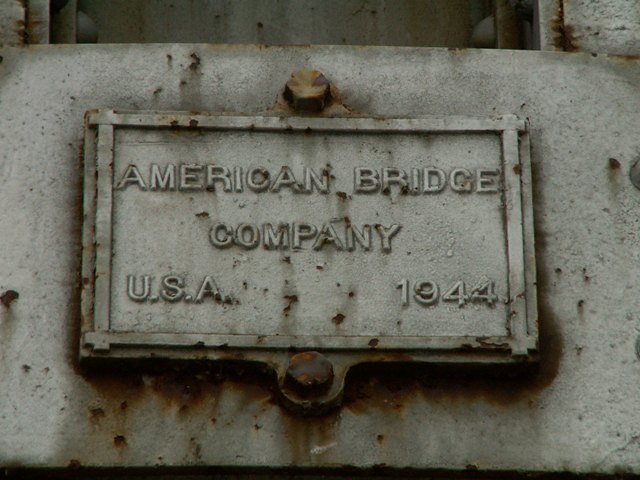We Recommend:
Bach Steel - Experts at historic truss bridge restoration.
BridgeHunter.com Phase 1 is released to the public! - Visit Now
Saginaw Bascule Railroad Bridge
CSX Saginaw River Bridge

Primary Photographer(s): Nathan Holth and Rick McOmber
Bridge Documented: Summer 2007
Saginaw: Saginaw County, Michigan: United States
Metal 8 Panel Rivet-Connected Warren Through Truss, Movable: Single Leaf Bascule (Abt) and Approach Spans: Metal 5 Panel Rivet-Connected Pratt Through Truss, Fixed
1944 By Builder/Contractor: American Bridge Company of New York, New York
Not Available or Not Applicable
160.0 Feet (48.8 Meters)
700.0 Feet (213.4 Meters)
15 Feet (4.57 Meters)
1 Main Span(s) and 5 Approach Span(s)
Not Applicable

View Information About HSR Ratings
Bridge Documentation
The west end of this bridge has one deck plate girder and three through truss approach spans. Going eastward, each truss approach span is a little larger than the next. The first two approach trusses are four panels, although the second one is a bit longer. The third, westernmost, of the approach spans has five panels. There are no approaches to the main bascule span at the eastern end. All the approach truss spans are riveted connection Pratt truss spans. This bridge was built in 1944 by the American Bridge Company and is a good example of the transition from v-laced and latticed built-up beams to a more plain built-up box beam that feature only punched holes. The approach spans do have v-lacing and lattice on the members and bracing however, while the bascule span has the punched hole box beams. The bascule span still has the v-lacing on the bracing however. The bascule span is an eight panel riveted connection through truss. The mechanics of the bascule span are very much like the Port Huron Railroad Bridge. The Port Huron Bridge is, like this Saginaw Bridge, inoperative. Unlike the Saginaw Railroad Bridge, the Port Huron example is always in the raised position. By comparing the two bridges you can see how the unusual counterweight swings between two positions as the bridge raises or lowers. The Port Huron bridge is an earlier example, with a 1931 construction date.
An advertisement for the American Bridge Company featured an Abt type bascule bridge built in Beaumont, Texas, similar in design to the Saginaw Bascule Bridge. However, the bridge in Beaumont Texas has been demolished. The Saginaw Bascule bridge is one of the few remaining examples of this bridge type in the country.
Above: View of the bridge from the river on August 15, 2020. Photo Credit: Don Glover
![]()
Photo Galleries and Videos: Saginaw Bascule Railroad Bridge
Structure Overview
Original / Full Size PhotosA collection of overview photos that show the bridge as a whole and general areas of the bridge. This gallery offers photos in the highest available resolution and file size in a touch-friendly popup viewer.
Alternatively, Browse Without Using Viewer
![]()
Structure Details
Original / Full Size PhotosA collection of detail photos that document the parts, construction, and condition of the bridge. This gallery offers photos in the highest available resolution and file size in a touch-friendly popup viewer.
Alternatively, Browse Without Using Viewer
![]()
Structure Overview
Mobile Optimized PhotosA collection of overview photos that show the bridge as a whole and general areas of the bridge. This gallery features data-friendly, fast-loading photos in a touch-friendly popup viewer.
Alternatively, Browse Without Using Viewer
![]()
Structure Details
Mobile Optimized PhotosA collection of detail photos that document the parts, construction, and condition of the bridge. This gallery features data-friendly, fast-loading photos in a touch-friendly popup viewer.
Alternatively, Browse Without Using Viewer
![]()
Maps and Links: Saginaw Bascule Railroad Bridge
Coordinates (Latitude, Longitude):
Search For Additional Bridge Listings:
Bridgehunter.com: View listed bridges within 0.5 miles (0.8 kilometers) of this bridge.
Bridgehunter.com: View listed bridges within 10 miles (16 kilometers) of this bridge.
Additional Maps:
Google Streetview (If Available)
GeoHack (Additional Links and Coordinates)
Apple Maps (Via DuckDuckGo Search)
Apple Maps (Apple devices only)
Android: Open Location In Your Map or GPS App
Flickr Gallery (Find Nearby Photos)
Wikimedia Commons (Find Nearby Photos)
Directions Via Sygic For Android
Directions Via Sygic For iOS and Android Dolphin Browser
USGS National Map (United States Only)
Historical USGS Topo Maps (United States Only)
Historic Aerials (United States Only)
CalTopo Maps (United States Only)




